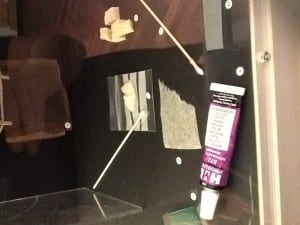Mending Glass! A new conservation display at the Petrie Museum
By Debbie J Challis, on 17 April 2012
Guest post by Rachel Farmer
Ever wondered how much work goes into conserving a single object? Ever wanted to try a bit of conservation yourself? A new exhibition at the Petrie Museum looks at the work done on Petrie objects by Conservation students at the Institute of Archaeology, UCL.
 The small pedestal case was chosen as a great place to put on exhibitions about the work that happens behind the scenes at the Petrie Museum. To start the ball rolling an exhibition on conservation has been installed which also highlights the close relationship between the Petrie Museum and the Conservation students from the Institute of Archaeology, UCL. During the Conservation course at the Institute the students are given objects from material groups and over a number of years many groups of students have been given glass vessels from the Petrie Museum’s collection to work on.
The small pedestal case was chosen as a great place to put on exhibitions about the work that happens behind the scenes at the Petrie Museum. To start the ball rolling an exhibition on conservation has been installed which also highlights the close relationship between the Petrie Museum and the Conservation students from the Institute of Archaeology, UCL. During the Conservation course at the Institute the students are given objects from material groups and over a number of years many groups of students have been given glass vessels from the Petrie Museum’s collection to work on.
The glass vessels come to the students in multiple fragments, often extremely thin and badly weathered. The task of putting all the pieces together is sometimes far too similar to recreating a light bulb someone has dropped on the floor. Their task is to create a stable object which can be handled and researched as well as stored safely. Having the glass vessels in the conservation laboratory also provides an opportunity for the objects to be analysed. Often there are grains of sand or unknown foreign material on the fragments and the students can use analytical equipment such as a Scanning Electron Microscope (SEM) to establish what the material is which could provide information on the context in which the vessel was found or Petrie’s excavation techniques.
The exhibition is located in the reception area of the Petrie Museum and contains examples of conserved glass vessels as well as materials that can be used in conservation treatments. Pictures and text have been put into an iPad in front of the case so that you can be taken through the whole treatment process or find out more about the materials on display.
By Rachel Farmer, UCL Conservation Intern at the Petrie Museum
 Close
Close


